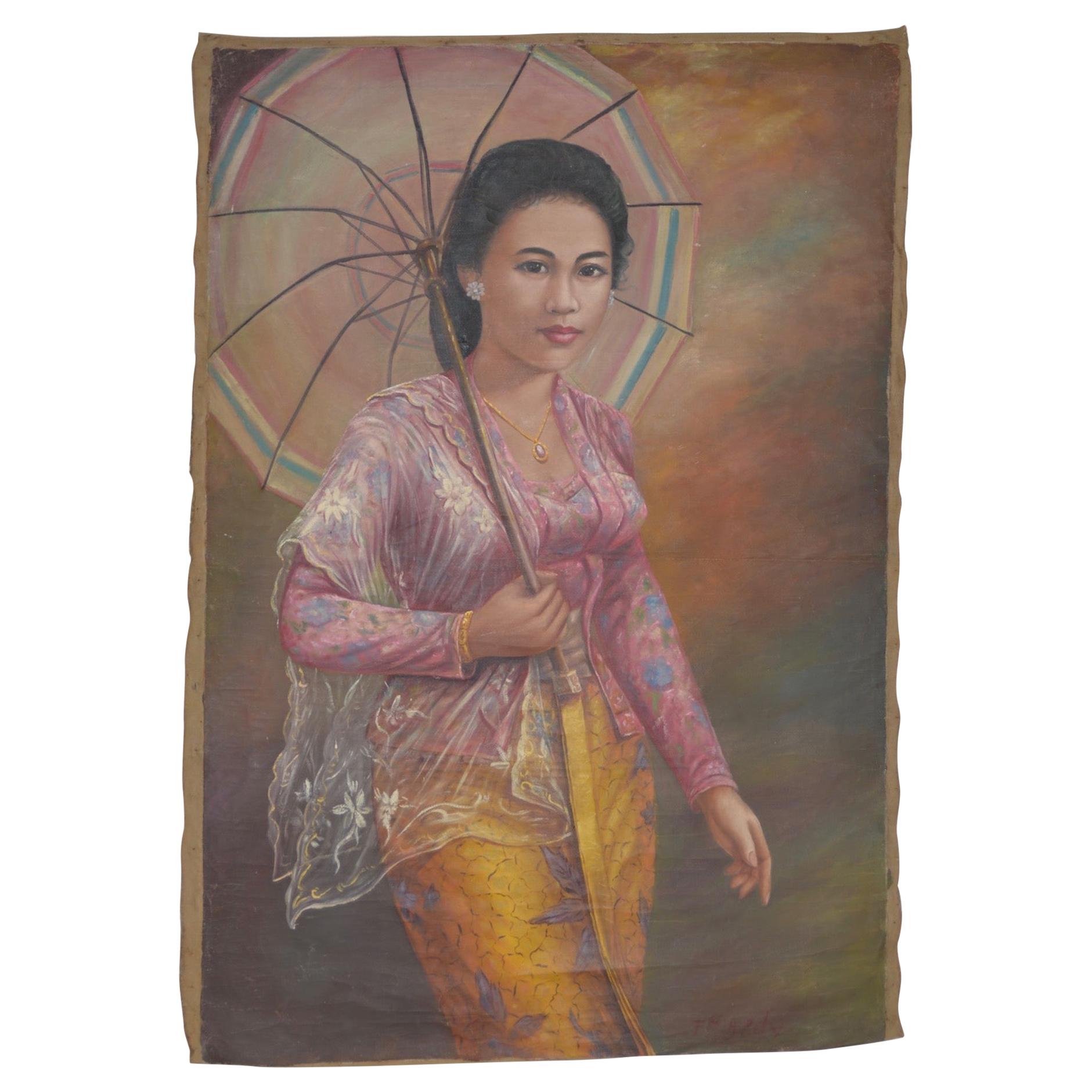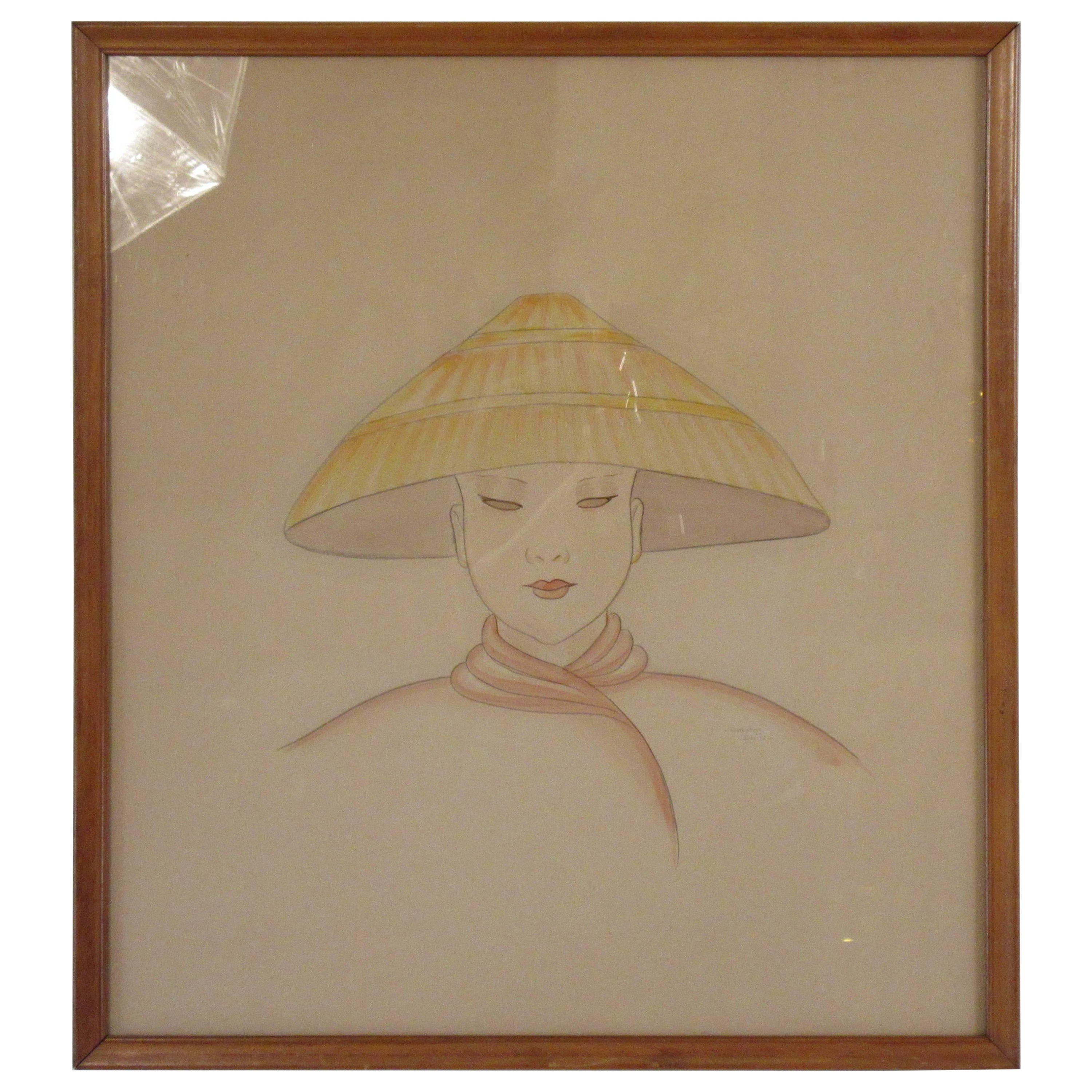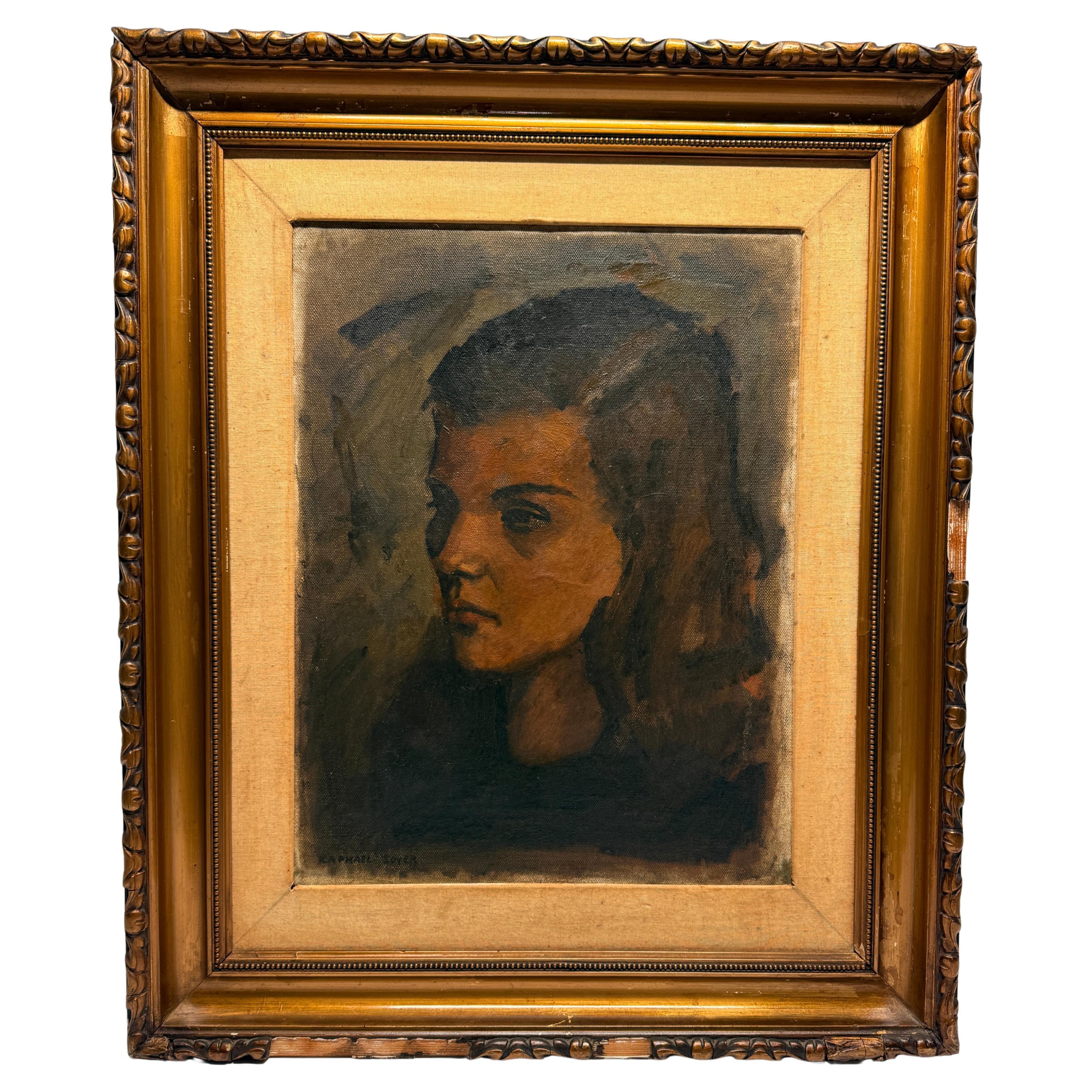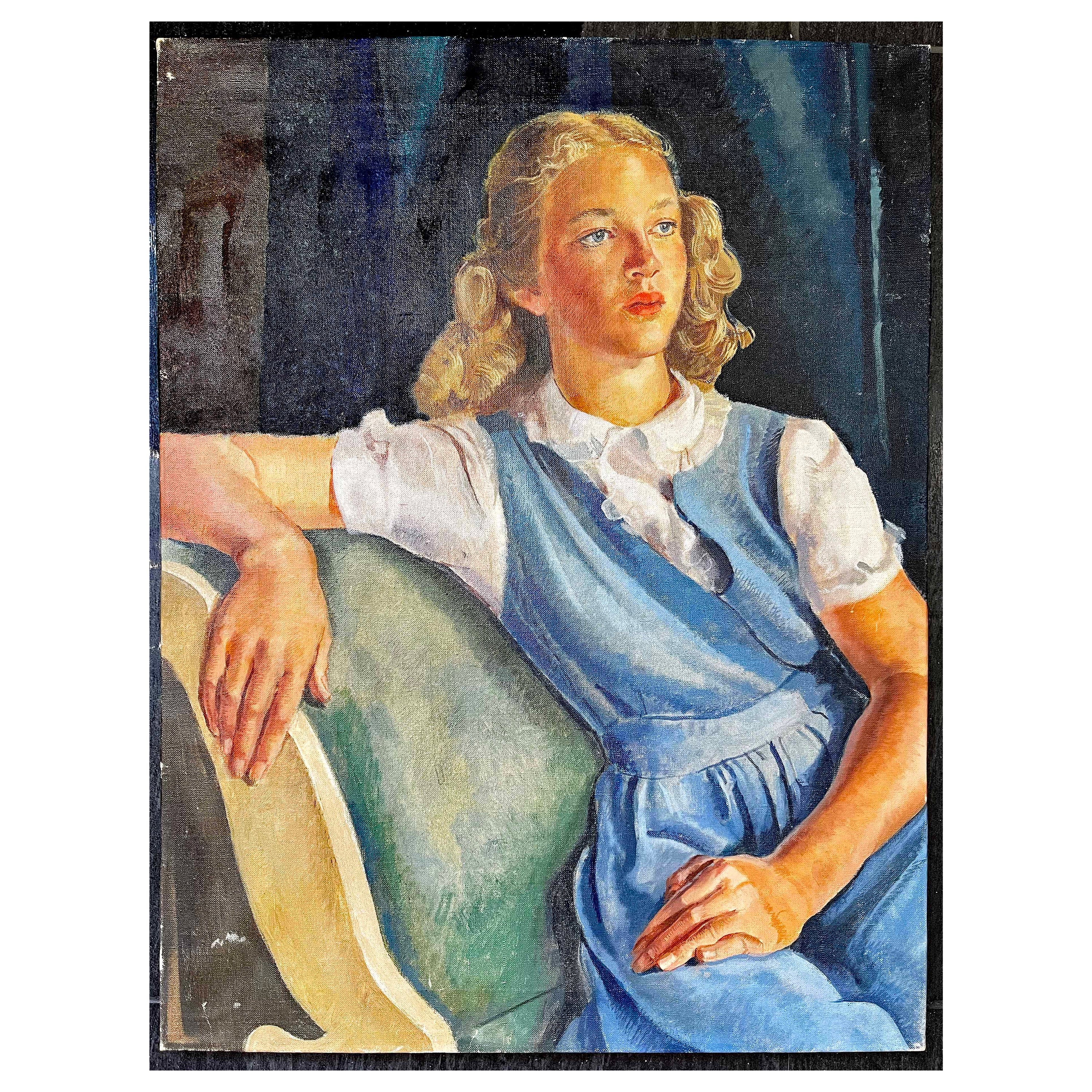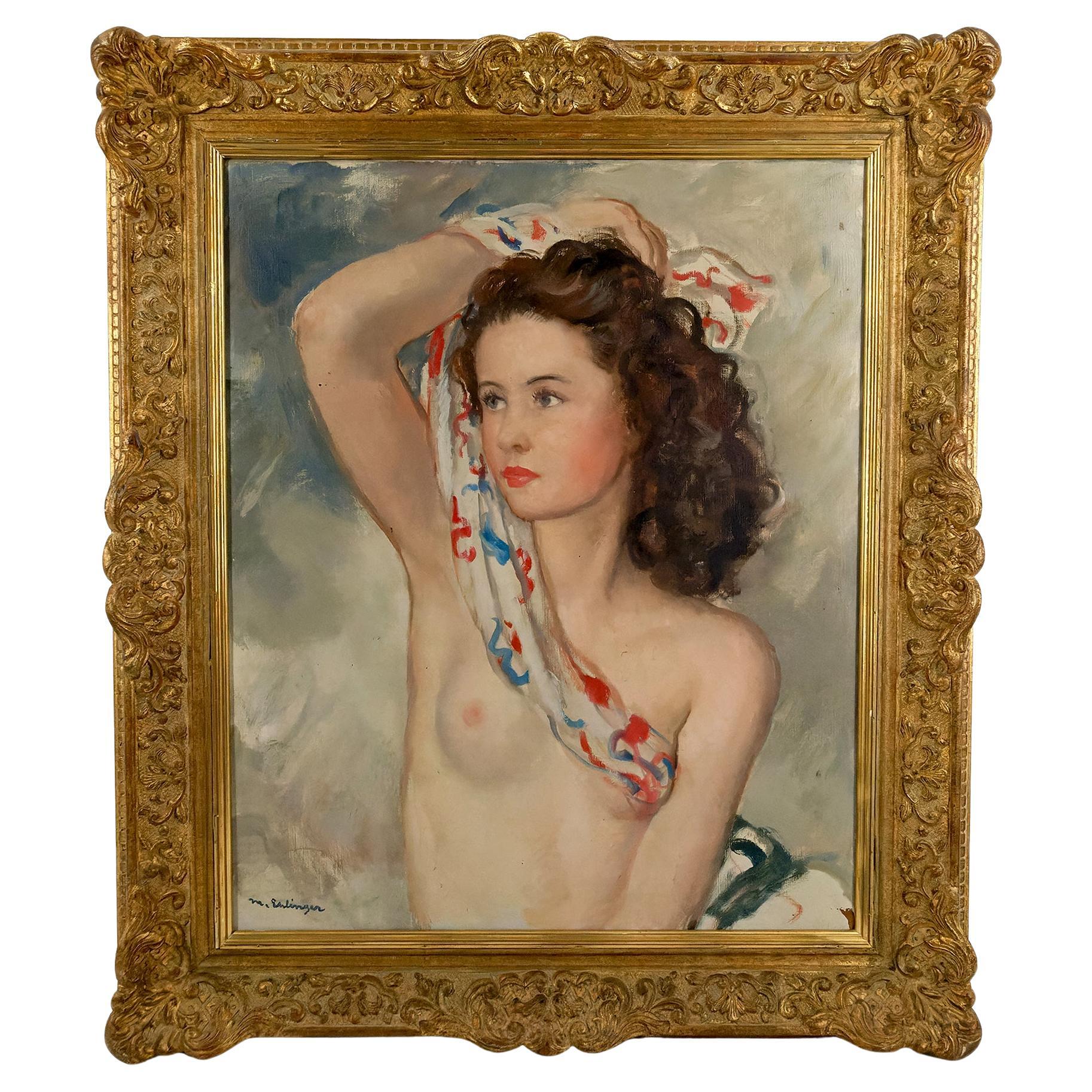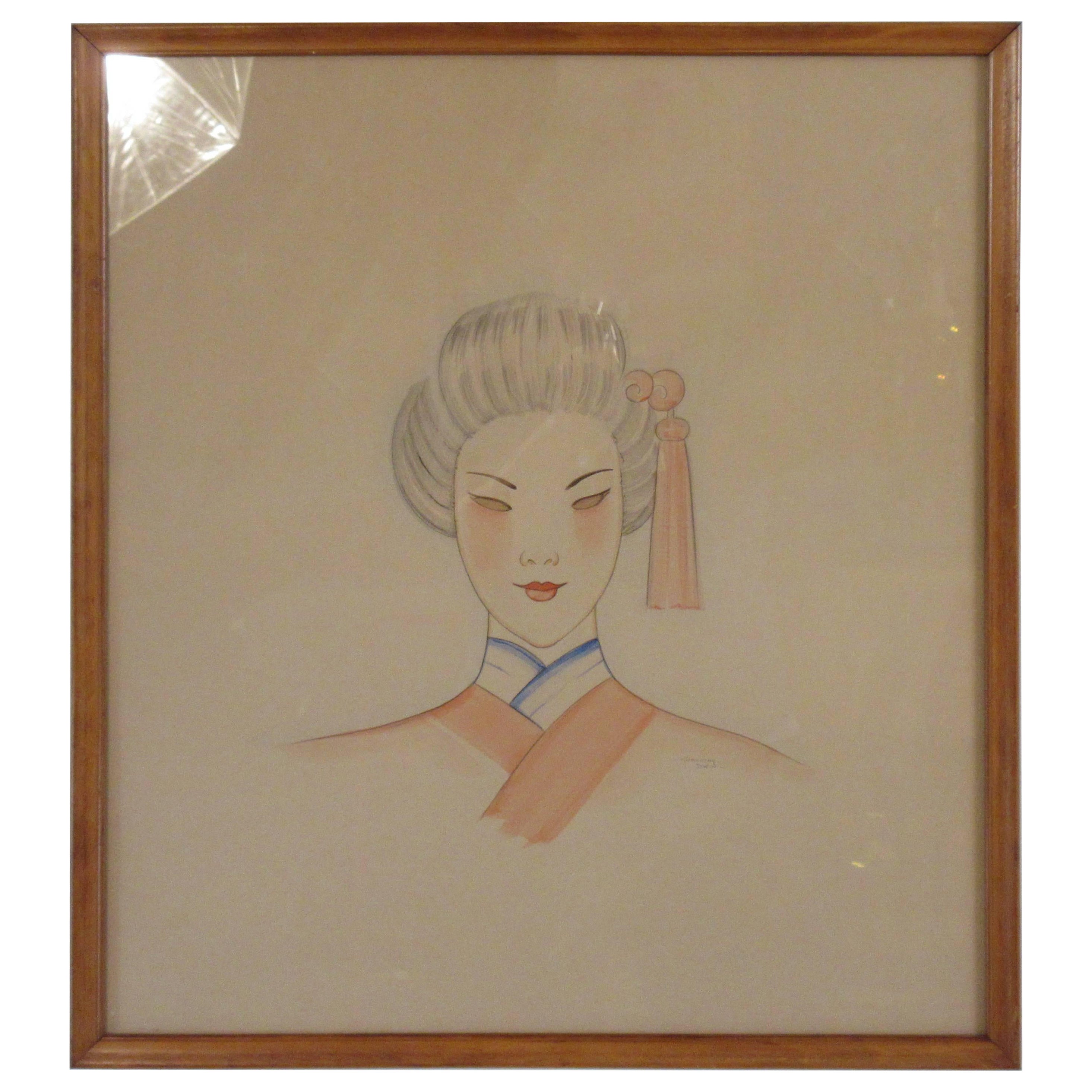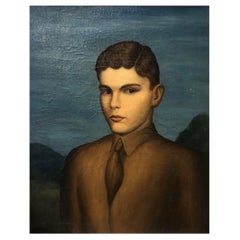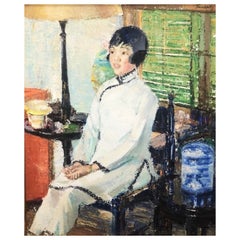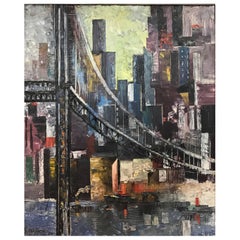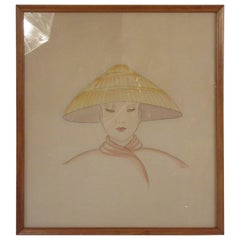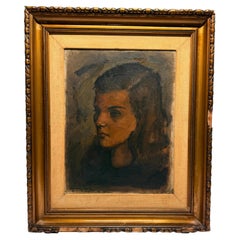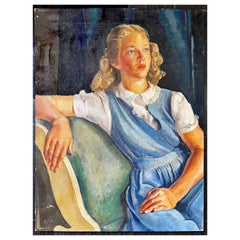Items Similar to Irina Shtenberg, Portrait of a Young Woman, Watercolor on Paper, circa 1940s
Want more images or videos?
Request additional images or videos from the seller
1 of 5
Irina Shtenberg, Portrait of a Young Woman, Watercolor on Paper, circa 1940s
About the Item
Unsigned.
Attributed to Irina Valeryanovna Shtenberg.
Period frame.
Dimensions (unframed): Height: 13”, width: 11”
Dimensions (framed): Height: 15”, width: 12-7/8”
All the works of this internationally famous artist characterized by the clarity of the picture, and sometimes underlined sharpness of the lines. The painter acutely felt the nature of the dramatic work and found a bright, bold solution to the stage space. Always strived for simplicity and lightness, Stenberg in her works of art had created a true and delicate atmosphere.
Irina Valeryanovna SHTENBERG (Russian/Georgian, 1905–1985) was a fascinating figure in the history of Russian and Georgian art, the Tbilisi avant-garde, and the art of the theater. She spent her youth in Georgia, where she graduated from the Tbilisi Academy of Art in the 1926, studying under Evgeny Lansere and Gigo Gabashvili.
Moving to Moscow in 1929, Shtenberg became a member of the artistic elite, working and exhibiting with Akimov, Tishler and members of the '13' artist group. With the support of Anatoly Lunacharsky, Soviet Peopel's Commissar of Education, she had first solo exhibtion in Moscow. While in Moscow, she contributed to influential avant-garde journals, such as ‘Rost’ and ‘30 days’. Unfortunately for Shtenberg, her husband, the high-ranking party functionary Alexander Kulidjanov, was arrested in 1937 and most likely executed. After returning to Tbilisi, she continued to work as a theatrical artist creating stage designs and decorations, working for the best theatres in Tbilisi.
Shtenberg is also known for her forays into erotic drawing, and her own sexuality has been the subject of much speculation over the years. Whether in her erotic drawings, her costume designs, or other works, Shtenberg always imbued a personality and humanity into her figures.
- Attributed to:Irina Shtenberg (Painter)
- Dimensions:Height: 13 in (33.02 cm)Width: 11 in (27.94 cm)Depth: 1 in (2.54 cm)
- Style:Mid-Century Modern (Of the Period)
- Materials and Techniques:
- Place of Origin:
- Period:
- Date of Manufacture:1940s
- Condition:Wear consistent with age and use. We make our best effort to provide a fair and descriptive condition report. Please examine the photos attentively, as they are an integral part of description. Send us a message to request more details or discuss price.
- Seller Location:New York, NY
- Reference Number:1stDibs: LU2819313832731
About the Seller
5.0
Vetted Professional Seller
Every seller passes strict standards for authenticity and reliability
Established in 1993
1stDibs seller since 2017
80 sales on 1stDibs
Typical response time: 2 hours
- ShippingRetrieving quote...Shipping from: New York, NY
- Return Policy
Authenticity Guarantee
In the unlikely event there’s an issue with an item’s authenticity, contact us within 1 year for a full refund. DetailsMoney-Back Guarantee
If your item is not as described, is damaged in transit, or does not arrive, contact us within 7 days for a full refund. Details24-Hour Cancellation
You have a 24-hour grace period in which to reconsider your purchase, with no questions asked.Vetted Professional Sellers
Our world-class sellers must adhere to strict standards for service and quality, maintaining the integrity of our listings.Price-Match Guarantee
If you find that a seller listed the same item for a lower price elsewhere, we’ll match it.Trusted Global Delivery
Our best-in-class carrier network provides specialized shipping options worldwide, including custom delivery.More From This Seller
View AllPaul Meltsner, Portrait of a Youth, American Modernist Realism O/C, c. 1940
Located in New York, NY
American Art Deco
Modernist Social Realism
Paul Raphael Meltsner
Portrait of a Youth
Oil on canvas
Circa 1940
DIMENSIONS
CANVAS: 26 x 20 inches
FRAMED: 30 .5 x 24.5 inches
DETAIL...
Category
Vintage 1940s American Art Deco Paintings
Materials
Canvas
David Anthony Tauszky, Portrait of a Chinese Woman, American Art Deco, ca. 1920s
Located in New York, NY
Dimensions: Height: 24” (61cm) Width: 20” (50.8cm) Frame width: 3.25” (8.12 cm)
About:
This very elegant painting is a part of the famous ‘Cantonese’ series of mainly female portraits, painter by David Anthony Tauszky...
Category
Vintage 1920s American Art Deco Paintings
Materials
Paint
Boris Solotareff, Portrait of Mr. Lautenberg, Oil on Canvas Painting, 1920s
By Boris Solotareff
Located in New York, NY
Signed en verso B. Solotareff, Lautenberg.
Original period frame, made personally by the artist.
Dimensions (without frame):
Height 16”
Width 12 ½”.
Dimensions (with frame...
Category
Vintage 1920s French Art Deco Paintings
Materials
Canvas
Sam Diamond, View of Manhattan, Oil on Canvas Painting, circa 1954
By Sam Diamond
Located in New York, NY
This is a double-sided painting -
Side 1: View of Manhattan, signed lower left and dated 1954.
Side 2 (reverse): Genre scene with porters.
Dimensions: Unframed: 20.5 x 30.5 inches Framed: 32 x 37 inches
Sam Diamond, Polish/American (1919 - 1978)
- Born May 1, 1919 in Warsaw, Poland.
- Family immigrated to the United States in November 1919.
- Began drawing at 6 years of age and continued an active interest in art throughout his school years.
- Graduated from Long Beach High School in 1936, at 16 years of age.
- Awarded a scholarship to Pratt Institute.
- Received art certificate from Pratt in 1939.
- Enlisted in U.S. Army Signal Corps. - Film Strip Division- doing artwork for training manuals from 1941-1946.
- Formed advertising art studio in 1946
- Continued painting and sculpture to present.
- Award for Sculpture and Painting, Westchester Art Society...
Category
Vintage 1950s American Mid-Century Modern Paintings
Materials
Paint
Rolph Scarlett, Modernist Abstract Composition, Guache on Paper, Ca. 1950’s
By Rolph Scarlett
Located in New York, NY
Artist: Rolph Scarletti (Canadian, 1889 – 1984)
Object: Modernist Abstract Composition
Period: Ca. 1950’s
Medium: Guache on paper, framed
Dimensions (unframed):
Height: 9-1/3”
Width: 12”
Dimensions (framed):
Height: 22-3/4””
Width: 25-3/4”
Rolph Scarlett (Canadian, 1889 – 1984) was a consummate explorer of twentieth-century abstract painting. Never afraid of trying new styles, curious and opinionated, constantly engaged with the world around him while steadfastly aware that he was on his own path and his alone, Scarlett more than once proved to be at the artistic zeitgeist of the eras in which he lived. Exposed very early on to the work of Paul Klee through a chance meeting in Europe with the artist himself, Scarlett took up abstraction with a fervor that never diminished during his long and impressive career. To create something that had never existed before: this was Scarlett’s great cause. And that is what is most obvious when you look at Scarlett’s work—you have never seen anything quite like it.
Scarlett was Canadian-born, came of age in the Midwest, and spent few important years in Hollywood, where he designed stage sets. His work from this early period echoes Klee’s use of color, his confidence in naïve, primitive forms, and his blend of abstraction and figuration. In its flat spatial qualities it prefigures the Indian Space painting of the 1940s by a decade. He moved to New York in 1933 and eventually found his first great patron at the Museum of Non-Objective Painting, directed by Baroness Hilla Rebay and art patron Solomon R. Guggenheim. Guggenheim would collect over 60 works by Scarlett for his collection, more than any other artist outside of Vasily Kandinsky and Rudolf Bauer.
As a frequent exhibitor and lecturer at the Museum of Non-Objective Painting (MNOP), Scarlett honed his sensitive feel for bodies in space and capitalized on his trademark use of bright, vivacious colors into accomplished, perfectly harmonized geometric works. However, Scarlett soon morphed these hard-edged forms into a nuanced expressionistic abstraction which, at its best, seems to be populated by dancing forms that animate the canvases. Along this way he was advised by Rudolf Bauer, the German expatriate and one of the originators of non-objective painting in the teens. Bauer had the idea for the Museum, and Rebay, his champion, had found in Solomon Guggenheim a patron for manifesting it. When Bauer emigrated just before World War II, he wanted to meet Scarlett. The two became friends, and Bauer advised Scarlett on his work over the course of many years. Even in a 1979 interview, Scarlett began to tear up as he recalled his first meeting with Bauer, a man whose work he "worshipped," describing that, "It was a touching moment for me, I’ll tell you."
Scarlett and Rebay also had a close, important relationship, one in which he bore the brunt of her sometimes condescending, if motherly, critiques and admonitions with tolerance and gratefulness. Eventually, though, he had to push back. In a letter from 1951 he writes, "I have noticed with growing amazement that during the past three years you have accepted less and less of my work—and, that same work, which you rejected has been accepted and shown in the best and largest shows all over this country."
This period—the late 1940s to the early 1950s—did in fact correspond to Scarlett’s most critical success, and to a return to the fanciful forms and characters of his pre-war work. At the same time, he found his own rhythm and complexity using a drip style similar to, though denser and more opaque than, the one made famous by Jackson Pollock, who had worked for many years at the MNOP and with whom he shared common influences. In 1949 he had a very well received solo show in 1949 at the Jacques Seligmann Gallery, reviewed very favorably in The New York Times: "The impression made by these paintings is one of originality and strength." He was also included in a juried show "American Painting Today" at the Metropolitan Museum of Art in 1950 and in the Whitney Annual of 1951. The curator for the Whitney show in fact bypassed a selection of Scarlett’s careful geometrics in favor of a new "lyrical" drip painting—one which he describes as having had "a helluva good time" making.
Rebay articulated her loss of control over Scarlett very keenly in one of her last official letters to him: "So your way ended in the horrid jungle it is in now; even a Mr. Pollock’s smearage was not bad enough for you to have a try at; and betraying yourself, you betrayed art and my faith in you, and my present disgrace by my failure to foresee such an outrageous possibility—since you even paint objectively now."
Yet, despite the fact that he was moving in his own direction when the change in leadership took place at the Museum of Non-Objective Painting and Rebay was forced out as director, Scarlett was hit hard. He understood this change rightly as a betrayal by the establishment. Scarlett was a unique individual and soul, and was affected personally and philosophically by the idea that the movement with which Scarlett had aligned his talents seemed to disappear overnight, and his life’s work rendered valueless.
Without the Museum’s support, Scarlett decided eventually to move to the artists’ community of Shady, New York, just outside of Woodstock. He had occasional shows throughout the years, but mostly settled down to regional obscurity. He began making jewelry, which had been his first trade, and it was following a show of his jewelry in 1975 at the Jaro Gallery, that he was rediscovered by Samuel Esses, and his wife Sandy.
Samuel Esses was a successful businessman and an avid collector. He always sought out that which was unusual and, like Scarlett, was ahead of his time in many ways. For example, in 1979, Sam became enthralled with the early graffiti appearing on the New York subway trains. With the sole goal of preserving these groundbreaking yet short lived works of art he was inspired to create "The Esses Studio," a painting warehouse and workshop for graffiti artists to work in a studio, collaborate, and paint on canvas. The biggest names of graffiti writing participated—Futura, Crash, Dondi, Zephyr, and Daze to name a few. The project was well received and provided critical validation at an important time for this alternative form of abstraction to be recognized by the established art world. The success of the "Esses Studio" helped fuel an alternative fire that would propel gallerists and curators to acknowledge other street artists and provide a foundation of acceptance for the early careers of Keith Haring and Jean-Michel Basquiat. It is not a stretch to say that what Esses saw in the graffiti art of the 1970s was very similar to what he saw in 1950s-era Scarletts—something raw, honest, and melding many twentieth century influences into one unique form. Inspired by the importance of the collection and the passion of the collector, Weinstein Gallery...
Category
Vintage 1950s Canadian Mid-Century Modern Paintings
Materials
Paper
Set of Six Japanese Meiji Period Imperial Portrait Paintings on Silk , Ca. 1880s
Located in New York, NY
Meiji Period (1868-1912) – Ca. 1880/1890
This group of portraits was shown at Chicago World’s Fair in 1893.
DIMENSIONS (Framed)
Width: 24” inches
Height: 57.5
Category
Antique 1880s Japanese Japonisme Paintings
Materials
Silk
You May Also Like
Young Elegant Asian Woman Oil on Canvas, circa 1940s
Located in San Francisco, CA
Young elegant Asian woman oil on canvas, circa 1940s
This is one of our favorite paintings. A young Asian woman out on a warm afternoon.
The quality of this painting cannot be ...
Category
Early 20th Century Chinese Chinese Export Paintings and Screens
Materials
Canvas
1940s Watercolor Painting On Paper Of Asian Woman Wearing Hat - Dorothy Dwin
Located in Tarrytown, NY
1940s Watercolor Painting On Paper Of Asian Woman Wearing Hat
Wearing a Nón Lá (traditional Vietnamese hat)
Signed Dorothy Dwin
Illustration
Category
Vintage 1940s Paintings
Materials
Paper
Raphael Soyer (American, 1899–1987) Portrait of a Young Woman, c. 1940s
By Raphael Soyer
Located in Atlanta, GA
Raphael Soyer (American, 1899–1987)
Portrait of a Young Woman, c. 1940s
Oil on canvas - Signed lower left "Raphael Soyer"
This intimate and introspective portrait by Raphael Soyer ...
Category
Mid-20th Century American Expressionist Paintings
Materials
Canvas, Paint
"Young Woman in Blue Dress", Stunning 1940s Portrait of Blonde Female
Located in Philadelphia, PA
This fresh and vibrant portrait of a young woman with glowing blond hair and a blue 1940s frock is one of the finest World War II vintage portraits we have ever offered. Her complex...
Category
Vintage 1940s American Art Deco Paintings
Materials
Paint
Nude Portrait of a Young Woman with a Scarf, Maurice Ehlinger, Circa 1940
By Maurice Ambroise Ehlinger
Located in VÉZELAY, FR
Nude Portrait of a Young Woman with a Scarf, Maurice Ehlinger, Circa 1940.
We present a rare and refined work by a master portraitist of the 20th century.
Details of the Artwork:
...
Category
Vintage 1940s French Art Deco Paintings
Materials
Canvas, Wood, Giltwood
Vintage Abstract Nude Portrait Woman Possibly WaterColor on Paper With Pencil
Located in Seattle, WA
Nude Portrait of a Woman. Bright Colors, Appears to be Watercolor on Paper. Signed JP Gaston. Wear and Tear Consistent with Age.
Dimensions. 24 W ; 18 D
Category
Vintage 1970s Mid-Century Modern Paintings
Materials
Paint
